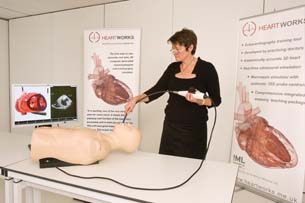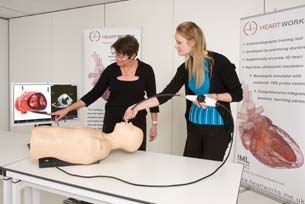Latest News
March 22, 2011
By Mark Priscaro
 |
In 2006, three clinicians at University College London Hospitals (UCLH) Heart Hospital, Drs. Sue Wright, Andrew Smith and Bruce Martin, got together to share their frustration about the lack of a realistic model of the human heart that could be used to teach cardiac anatomy. They came up with the idea of creating a virtual heart, and quickly realized that if it were based on an anatomical 3D data set, such a model could be used to generate a simulated ultrasound image.
The idea had significant implications for training, as it could also be used to simulate the experience of administering a transesophageal echocardiogram (TEE, known as TOE in the UK). This is an examination difficult to practice, as it relies on inserting an internal probe to capture images of a patient’s beating heart.
When these clinicians shared their idea with the team of creative artists at award-winning, UK-based visual effects company Glassworks, things began to take shape. The goals were to create an anatomically accurate, computer-generated heart model that could instantly produce an authentic ultrasound representation, be animated to beat in real-time to show changes in the heart's shape during the cardiac cycle, and enable the doctor to view slices of the scene to gain valuable diagnostic insights.
The clinicians and Glassworks named the project HeartWorks, and relied on the high-performance computing and visualization power of NVIDIA Quadro professional graphics solutions in the development and use of this first-of-its-kind clinical training tool.
 |
Laying the Groundwork
A small team of artists and developers at Glassworks began collating a vast set of digital heart images, including attending open-heart surgery to experience the human heart beating live. Wright, Smith and Martin worked with leading surgeons, cardiac morphologists, ultrasonographers and other experts to consult with Glassworks as the system began to develop.
To create the complex realistic heart model and real-time animations, the Glassworks artists and animators used Autodesk Softimage 3D animation software running on workstations equipped with NVIDIA Quadro graphics processing units (GPUs). These professional graphics solutions provided the processing power necessary to render high-quality images at 30 frames per second—keeping the animations realistic and smooth.
“Immersive technology, where users can interact with 3D images on a screen, has been limited historically by the state of graphic technology, and by budgets,” notes Hector McLeod, founder of Glassworks. “NVIDIA’s breakthrough with their massively parallel GPU technology has changed that.
“In any given frame we’re tapping the GPU to examine the model, slice it, annotate the views and display the two visualizations—the model and the ultrasound—in less than 1/30 of a second,” he adds.
The model has a high polygon count (250,000), and HeartWorks is generating two simulations, plus an entire system of anatomic labels. Glassworks software engineer David Llewellen reports that the NVIDIA Quadro is “easily handling the sheer quantity of data we’re pushing through it. To get the model to look graphically superior, we also have highly detailed textures; the majority using OpenGL and running GL Shader Language. We need all of that processing power at once to make sure HeartWorks delivers a real-time experience.”
Glassworks and the UCLH Heart Hospital clinicians commercialized HeartWorks through Inventive Medical Ltd. in London, which integrates, installs and supports the system for hospitals, labs and universities. When it is delivered to clients, the HeartWorks product is a turnkey system that includes the HeartWorks software: the interactive, virtual heart model and ultrasound simulation program; a high-performance workstation equipped with an NVIDIA Quadro professional graphics card; a monitor/keyboard/mouse; and a probe and torso mannequin to enable a hands-on experience for teaching the TEE procedure.
Case in Point
One of HeartWorks’ early adopters was Duke University—specifically, the Department of Anesthesiology, Division of Cardiothoracic Anesthesia and Critical Care Medicine. The department bought the simulator early in 2009 to teach residents and fellows in its advanced TEE program. First-, second- and third-year residents use it primarily to learn basic echocardiographic views and anatomy, while fellows in the advanced program use it to examine more subtle features.
“Simulation technology has enabled us to take a quantum leap forward in our teaching,” says Dr. Madhav Swaminathan, MD, FASE, FAHA, of Duke University School of Medicine’s Division of Cardiothoracic Anesthesia. “This particular system essentially simulates the beating heart clearly. To explain how an ultrasound image is formed and how it correlates to anatomical features is extremely difficult. When you’re changing the image plane with a probe, it’s hard to understand what parts of the heart you are seeing on the screen—because the heart is three-dimensional, and you’re using 3D on a 180-degree plane. A simulator makes it possible to see side-by-side not only how an ultrasound image is generated, but what the cuts mean in a controlled, relaxed environment where you don’t have to worry about interfering with a patient’s clinical care or taking too much time. This virtual environment technology gives residents a jumpstart.”
Swaminathan says the primary advantage of the simulation technology is the real-time interaction residents and fellows experience: “When you can see the heart beating and modify aspects of it, cut it, and manipulate it at will, versus being forced to do it the way a teacher wants, is a significant breakthrough in echo education.”
The Future
Following its success with the TOE/TEE application simulator, the UCLH Heart Hospital/Glassworks team began developing another HeartWorks device, a TTE, which simulates the experience of an external ultrasound examination. It uses the same virtual heart model as the original HeartWorks application, but the interaction via probe generates a slice plane that goes through the lungs and ribs, which are also visualized.
In the development of the new TTE application, Glassworks is investigating further leveraging NVIDIA’s Quadro GPU technology by writing shader tools in the NVIDIA CUDA programming language to give them an additional performance boost.
“We’d love to make further optimizations that make things run even faster, and look even better,” Llewellyn says. “We will make full use of whatever developments NVIDIA brings along next.”
The author is senior public relations manager for NVIDIA Corp., Santa Clara, CA.
More Info:
NVIDIA
Glassworks
University College London Hospitals Heart Hospital
Subscribe to our FREE magazine, FREE email newsletters or both!
Latest News
About the Author
DE’s editors contribute news and new product announcements to Digital Engineering.
Press releases may be sent to them via [email protected].






